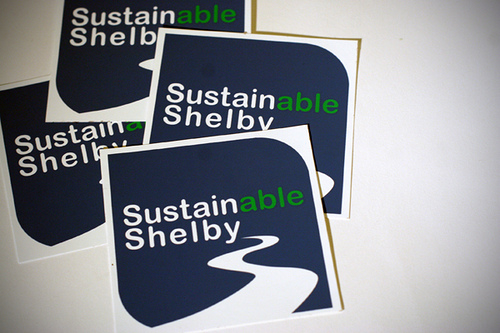Truth be told, most people thought that the Sustainable Shelby report would likely end up in the same place as dozens of other local government plans, studies, and reports – on a dusty shelf and long forgotten.
Sustainable Shelby was the first agenda for sustainability in the Memphis region and a strategic framework that addressed building codes, the environment and neighborhood rebirth. It made the connections between transportation and traffic, public incentives for economic development and land use patterns. The plan looks close to home by improving public building efficiency and purchasing policies, while looking far down the road at development opportunities, natural resource preservation and tax revenues.
Sustainable Shelby was developed through a process coordinated by 13 Shelby County employees and seven committees chaired by private architects, Sierra Club and neighborhood development leaders, urban planning professors, real estate professionals and community activists. These committees consisted of almost 150 experts in their respective fields who each volunteered an extraordinary amount of time to a project that they believed would be a seminal moment in the history of Shelby County.
For the first time in this kind of process in this community, a public poll was taken so that the public’s voice could be heard in setting priorities. In setting the final priorities, the committees’ votes counted for 50% and the public’s opinions as expressed in the poll counted for the other half.
Defying the Odds
Sustainable Shelby was launched by then-Shelby County Mayor A C Wharton, and it seemed dormant after he moved to City Hall. And yet, after 21 months, the community’s first sustainability program was resurrected by the Luttrell Administration. Paul Young, a policy adviser to Shelby County Mayor Mark Luttrell, was named to head up the office which became part of the Memphis and Shelby County Division of Planning Development (whose staff wrote the implementation action steps).
And yet, even then, there were still plenty of skeptics who thought the plan would get only lip service. The good news is that the energetic Mr. Young – along with his dedicated staff members Christine Donhardt and John Zeanah – have covered an incredible amount of ground to address the lengthy, complicated agenda laid out by Sustainable Shelby.
You can see exactly how much they have gotten done in the 38 pages of its Sustainable Shelby Progress Report 2014, which is chock full of facts and updates. That’s one of the things we’ve most admired about the work of the Office of Sustainability: its commitment to complete transparency. For example, although it knew that some people (like us) would push back hard against the TN 385 study for the way it ignored the economic heart of the region – Memphis – in assessing the impact of the new semi-circumferential highway (actually, the sustainability office managed the report for Shelby County Government and it reflected county government’s often blind eye when it comes to Memphis). But despite that, it pushed out the report along with other documents and studies that were prepared along the way. That’s why they are a compelling model for the rest of city and county governments, which need to adopt a policy to post every report, study, and plan online.
To underscore their commitment to transparency, the sustainability office did something really rare in government. It did more than publish a narrative report. It also listed every recommendation in the original Sustainable Shelby report and reported, what they have accomplished (or not accomplished), and 56% of the recommendations have been accomplished or they are in process. It’s another way that the office is a model for all of city and county governments.
Our Favorite Data Points
We acknowledge that we are data addicted, but the Sustainable Shelby Progress Report does a good job of satisfying our need for numbers with readable information about each segment of the report. That said, there were several data points that were illuminating to us:
* City of Memphis manages more than 600 facilities with energy costs of $16.4 million, which suggests the potential for substantial savings that could result from strategic efficiencies.
* Shelby County manages more than 100 facilities with energy costs of $6.6 million. It has already completed an efficiency review aimed at cutting costs.
* City of Memphis has 5,130 vehicles and Shelby County has 1,768 vehicles. Memphis’ fuel costs are $14 million and Shelby County’s are $2.2 million. Proportionally, county government’s costs are significantly less than city government’s so we hope someone in City Hall is checking to see if county government has any secrets to share.
* Daily Vehicle Miles traveled in Shelby County (2012): 24,159,256 miles.
* Daily Vehicle Miles traveled in Shelby County per capita: 25.68 miles.
* Total miles of bike lanes in Memphis in 2009 and 2013: 2 miles vs. 74 miles.
* Shared use lanes in 2009 in Memphis and in 2013: 15 miles vs. 31 miles.
* Total countywide energy consumptions in the past three years has decreased 16.45%.
* Average recycling per capita countywide from 2009 to 2012: 36 pounds.
* Average annual amount recycled from 2009 to 2012: 197,854 tons.
* Average amount recycled – Memphis compared to Germantown: 27 pounds to 137 pounds.
* Ranking of Memphis in recycling among seven Shelby County municipalities: #5.
* Number of Project Green Fork restaurants in 2009 compared to 2013: 17 vs. 56.
Award-winning Work
In November, 2011, Shelby County Government received a $2.6 million federal grant to create the Mid-South Regional Greenprint and Sustainability Plan, a regional network of green spaces covering 18 municipalities in four counties in three states. It is perhaps the most ambitious project of its kind in the Memphis region, and if the Office of Sustainability had been able to accomplish that alone, it could declare victory.
But the fact that a staff of only three people have managed to coordinate that complex process while keeping its attention focused on the myriad recommendations in the Sustainable Shelby makes them our candidates for public employees of the year.
Appendix: Top 10 Priorities from Sustainable Shelby Public Process
1 Create/reinvest in a great public realm that includes parks, schools, streets, plaza that are appropriately scaled – one size does not fit all
2 Create/reinvent in great neighborhoods – not merely subdivisions – that are “complete,” walkable, and provide a sense of neighborhood
3 Amend existing Technical Codes to eliminate obstacles to sustainable growth
4 Produce a comprehensive plan for Memphis and Shelby County that includes guiding principles that provide a clear, predictable, position vision
5 Design new public buildings to be flexible and adaptable to potential changes in future use
6 The public sector should emphasize the adaptive reuse of existing buildings
7 Amend local regulations for demolition activities to identify and enact incentives which encourage building reuse when feasible and material recycling when demolition is needed
8 Provide incentives for reclaiming declining property in established neighborhoods
9 Adopt comprehensive, community-based watershed management strategies as the driver of water quality, quantity, and habitat decisions
10 Create/enhance bike lanes and pedestrian facilities to identify routes that can easily be striped for bicycle lanes, ensure dedicated funding through capital improvement program for the above identified routes, and install “share the road” signs
(Note: This firm was proud to be involved in the development of Sustainable Shelby.)





Thanks for your interest in Sustainable Shelby!
For updates on Sustainable Shelby, follow us on twitter @SustainShelby or like us on facebook:
https://www.facebook.com/pages/Memphis-Shelby-County-Office-of-Sustainability/217893028232155
or join our mailing list by contacting us here: http://www.sustainableshelby.com/contact
I agree!! The Greenprint has been a true model of sustainability planning and, in that genre, one of the most forthright in examining the Fair Housing implications of the county-wide infrastructure of walkable, bikeable and accessible amenities it proposes. HUD is delighted to have been able to contribute to this effort.
I give kudos and great thanks to Mayor Luttrell for throwing his support behind this effort. It would have been easy to let it die (or kill it, as his immediate predecessor tried to.) I think he wisely realized that not only is a community that values sustainability attractive to employers and workers, implementing the plan also will yield quite a few dollars and cents in savings.